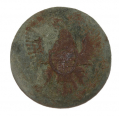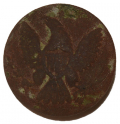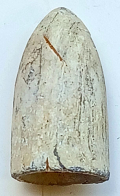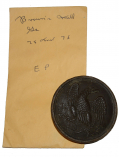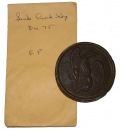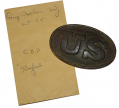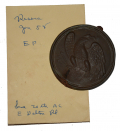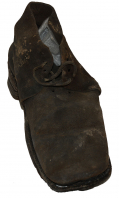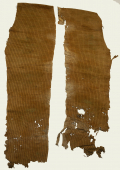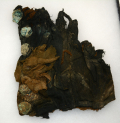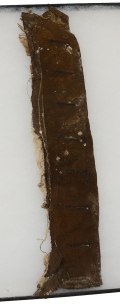site search
online catalog
Relics
Showing 121 to 140 out of 397
CIVIL WAR-INDIAN WAR FORAGE CAP VISOR
This is a well preserved leather visor from a forage cap recovered at Fort Pembina, ND, where it was preserved in remarkable condition by wet, anaerobic soil conditions. This is typical of the simple… (1052-480). Learn More »
CIVIL WAR-INDIAN WAR FORAGE CAP VISOR
This is a well preserved leather visor from a forage cap recovered at Fort Pembina, ND, where it was preserved in remarkable condition by wet, anaerobic soil conditions. This is typical of the simple… (1052-483). Learn More »
RELIC -- US NAVAL WATERCAP FUSE DATED 1862
Excavated naval watercap fuse dated 1862 and in very good condition. This brass fuse is made of brass with flange on top, with threaded portion and tapered body. This type of fuse was utilized by the… (84-84). Learn More »
US GENERAL SERVICE EAGLE COAT BUTTON RECOVERED AT 3RD CORPS HOSPITAL SITE, GETTYSBURG – KEN BREAM COLLECTION
Light green color to face, with light chocolate patina to body of eagle. Reverse is also green in color; shank present. No visible backmark. This button was found by local Gettysburg resident and… (1163-219F). Learn More »
US GENERAL SERVICE EAGLE COAT BUTTON RECOVERED AT 3RD CORPS HOSPITAL SITE, GETTYSBURG – KEN BREAM COLLECTION
Reddish chocolate patina with a few spots of verdigris on face. Shank present – somewhat loose though still securely held within the two sections of the button. No visible backmark. This button… (1163-219C). Learn More »
GETTYSBURG WITNESS TREE TRAY
This item was custom made by Todd Orndorff from reclaimed wood from a Witness Tree that once stood on the grounds bordering the Bloody Wheatfield on the Gettysburg battlefield. The oak tree would have… (1250-01). Learn More »
GETTYSBURG WITNESS TREE TRAY
This item was custom made by Todd Orndorff from reclaimed wood from a Witness Tree that once stood on the grounds bordering the Bloody Wheatfield on the Gettysburg battlefield. The oak tree would have… (1250-03). Learn More »
GETTYSBURG WITNESS TREE COASTER SET
This item was custom made by Todd Orndorff from reclaimed wood from a Witness Tree that once stood on the grounds bordering the Bloody Wheatfield on the Gettysburg battlefield. The oak tree would have… (1250-04). Learn More »
.69 CALIBER "NO-RING PRUSSIAN" BULLET
This was for the .69 caliber rifled muskets being used in the Federal service. These were machine "pressed and turned" bullets made at a Federal arsenal. This particular style features no grooves,… (2024-919). Learn More »
RELIC U.S. ENLISTEDMAN’S EAGLE BREAST PLATE FROM BROWN’S MILL, GEORGIA, RECOVERED BY SID KIRKSIS
This excavated Pattern 1839 US cartridge box shoulder sling plate (Eagle breast plate) has a smooth brown patina. The brass face features an eagle clutching arrows and an olive branch. The plate’s… (490-6828). Learn More »
RELIC U.S. ENLISTEDMAN’S EAGLE BREAST PLATE FROM SNAKE CREEK GAP, RECOVERED BY SID KIRKSIS
This excavated Pattern 1839 US cartridge box plate has a smooth brown patina on the face. The oval brass face features a raised “US”. The plate’s reverse has 99% of the lead fill. The two iron… (490-6829). Learn More »
RELIC U.S. ENLISTEDMAN’S CARTRIDGE BOX PLATE MARKED “E. GAYLORD” FROM KENTUCKY, RECOVERED BY SYD KIRKSIS
This excavated Pattern 1839 US cartridge box plate has a smooth brown patina on the face. The oval brass face features a raised “US”. The plate’s reverse has 99% of the lead fill. The two iron… (490-6831). Learn More »
RELIC U.S. ENLISTEDMAN’S EAGLE BREAST PLATE FROM RESACA, MAKER MARKED, RECOVERED BY SID KIRKSIS
This excavated Pattern 1839 US cartridge box shoulder sling plate (Eagle breast plate) has a smooth brown patina. The brass face features an eagle clutching arrows and an olive branch. There is one… (490-6830). Learn More »
$395.00
ON HOLD
RARE CLEBURNE BULLET – DEAN THOMAS COLLECTION
Dug Confederate “Cleburne” bullet .54 caliber. This is a rare Confederate bullet from the Trans-Mississippi theater. Very few specimens exist. Named such due to them being found in a bivouac site… (236-969). Learn More »
CONFEDERATE “BABY” WISHBONE FRAME BUCKLE FROM NASHVILLE
One of the more distinctive Confederate belt buckles is the forked-tongue or wishbone frame style from the shape of the movable tongue mounted on the center bar. The buckle is practical, light-weight,… (490-5846). Learn More »
SCARCE CIVIL WAR ARMY ISSUE SHOE, A.K.A. BROGAN OR BOOTTEE
This Civil War US army issue shoe is typical wartime construction, using rough-side out black leather with reinforcing heel piece or “counter” sewn inside, four pairs of holes for a leather lace,… (1052-282). Learn More »
KNIT DRAWERS OR TROUSERS FROM FORT PEMBINA
These pieces are two legs from trousers or, more likely, drawers recovered in the excavations at Fort Pembina, ND, conducted on private property with the owner’s permission, where wet, anaerobic… (1052-446). Learn More »
CIVIL WAR-INDIAN WAR UNIFORM COAT PIECE WITH BUTTONS FROM FORT PEMBINA
This comes from the right lapel of a US army coat discarded by a soldier at Fort Pembina, ND, sometime between 1870 and 1895, and is from excavations in wet, anaerobic soil that has preserved leather… (1052-580). Learn More »
INDIAN WAR FIELD-USED CAMPAIGN HAT FROM FORT PEMBINA, NORTH DAKOTA
This is a real field-used Indian War campaign hat in relic condition excavated at Fort Pembina, ND, a small frontier army post in operation from 1870 to 1895. Anaerobic conditions of the dig have… (1052-253). Learn More »
US ARMY DRESS COAT LAPEL FROM FORT PEMBINA, ND
This coat lapel comes from the left side of US army dress coat discarded by a soldier at Fort Pembina, ND, and was excavated in wet, anaerobic soil that has preserved leather and cloth in remarkable… (1052-589). Learn More »
Showing 121 to 140 out of 397
Most Popular
Historical Firearms Stolen From The National Civil War Museum In Harrisburg, Pa »
Theft From Gravesite Of Gen. John Reynolds »
Selection Of Unframed Prints By Don Troiani »
Fine Condition Brass Infantry Bugle Insignia »
British Imported, Confederate Used Bayonet »
Scarce New Model 1865 Sharps Still In Percussion Near Factory New »
featured item
FANTASTIC FRAMED DRAWING OF THE BATTLE OF DRAINSVILLE DONE BY GETTYSBURG CARTOGRAPHER EMMOR B. COPE
This wonderful and detailed drawing shows the meeting engagement on December 20, 1861 between a brigade of Pennsylvania Reserve regiments under Brig. Gen. E. O. C. Ord and a mixed Confederate force led by Gen. J. E. B. Stuart. The scene was drawn by… (1054-2733). Learn More »
site search
Upcoming Events
APRIL 12-13: SPRING GETTYSBURG MILITARY ANTIQUES SHOW; All Star Events Complex Learn More »






